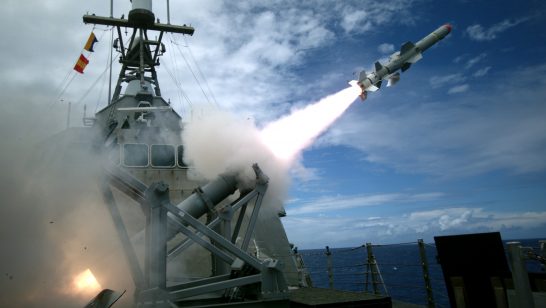
As the world watches with disbelief the Russian Federation’s invasion of Ukraine, Europe must once again face the uncomfortable reality of Russia-West competition. The stakes couldn’t be higher and have long-term ramifications for the international order: one nuclear power seeks to alter, by military force, the world order; other nuclear powers try to subvert this military adventure. At the same time, the aim must be a comprehensive ceasefire to enable all parties concerned to find a diplomatic solution to the conflict. Russia’s war against Ukraine may fuel the risk of an imminent nuclear catastrophe, which Russia in particular and the international community as a whole must avoid.
Russian President Vladimir Putin has sent a chilling reminder of the nuclear dangers in this war. In a televised address announcing the war against Ukraine on 24 February 2022, President Putin reminded the West — implicitly — that Russia does not exclude using nuclear weapons first in a conflict: “A few words to those who might be tempted to interfere in the unfolding events from the outside. Anyone who tries to hinder us and… create a threat for our country and our people must know that the response will be immediate and will lead to consequences.”
To underscore this, on 27 February, in a televised meeting with Russian defence minister Sergei Shoigu and the chief of the general staff, General Valery Gerasimov, Putin highlighted once again the nuclear threat by moving Russia’s nuclear forces to “a special combat duty regime.”
Although undoubtedly a message to deter the West from increasing its support for Ukraine, moving Russia’s nuclear forces to “combat duty” could be seen as a step towards nuclear use. As one Russian nuclear weapons expert noted, Russia’s command and control system cannot process launch orders in peacetime, so the move to “combat duty” “bring[s] the system into a working condition, connecting the wires, so if a launch order is issued it can go through.”
These developments lower the threshold for nuclear use, underlining fears that the nuclear-armed states no longer view nuclear weapons solely as political weapons of deterrence. Instead, some nuclear-armed states, including Russia, seem to embrace nuclear armaments as military weapons usable in a range of scenarios. This notion is at odds with their joint January 2022 affirmation of the Reagan-Gorbachev formula that “a nuclear war cannot be won and must never be fought.”
One intentional pathway to nuclear use in this conflict could be applying the highly controversial “escalate-to-de-escalate” strategy, which Western powers believe Russia has adopted in recent years but which the Russian Federation has denied. According to the 2018 U.S. Nuclear Posture Review, “Russian strategy and doctrine emphasize the potential coercive and military use of nuclear weapons. It mistakenly assesses that the threat of nuclear escalation or actual first use of nuclear weapons would serve to ‘de-escalate’ a conflict on terms favorable to Russia.”
But perhaps the single most significant risk of nuclear use in this conflict stems from unintentional escalation. Ahmet Üzümcü, Goran Svilanović, Maximilian Hoell
But perhaps the single most significant risk of nuclear use in this conflict stems from unintentional escalation. As French President Macron warned in his 7th February 2020 speech at the Ecole de Guerre, “global uninhibited strategic competition…could generate risks of incidents and uncontrolled military escalation … unbridled escalation of a local conflict into a major war is one of the most worrying scenarios today.” For example, NATO’s and Russia’s actions could be misinterpreted or misunderstood by the other side, leading to an inadvertent escalation of conflict. Given President Putin’s warnings to NATO to stay out of the war, Russia might misinterpret NATO’s actions as a provocation that could trigger Russian escalation.
The war in Ukraine will also inevitably bring Russian forces close to NATO borders, fuelling the possibility of a close encounter.
Another nuclear danger involves the potential for what Ukrainian president Volodymyr Zelensky described as “nuclear terror”; that is, a Russian attempt to take one of Ukraine’s nuclear power plants going awry either by directly hitting a nuclear reactor or by accidentally destroying a nuclear power plant’s electricity supply. The latter could lead to “what happened at Fukushima in 2011, where a loss of power led to a loss of cooling, which caused a meltdown of three of its nuclear reactors.”[1]
Implications for multilateral nuclear diplomacy
Even if the above scenarios do not materialise, Russia’s invasion of Ukraine represents a significant setback for multilateral nuclear non-proliferation and disarmament diplomacy. Multilateral deliberations between the P5 to progress their obligations under the NPT were already difficult before the invasion. Encouragingly, following years of conversations between the P5 and engagement by the European Leadership Network, the P5 formally agreed to address strategic risk reduction in the P5 process through a dedicated workstream with the publication of their working paper in December 2021. This progress is undone, with one Western official describing the P5 process in private conversations with the ELN as “dead”.
For the broader Non-Proliferation Treaty (NPT), Russia’s invasion of Ukraine, along with its threats to use nuclear weapons, is likely to polarise the membership further. Some states will increasingly see nuclear weapons as an indispensable means to deter aggression by another state. Svitlana Zalishchuk, a foreign policy adviser to the Ukrainian deputy prime minister, stated that the Russian Federation would not have invaded Ukraine “if we were the owner of nuclear weapons.” Similarly, Yuri Kostenko, Ukraine’s lead negotiator of the 1994 Budapest memorandum (which led to Ukraine’s accession to the NPT as a non-nuclear-weapon state), argues that it was “a terrible mistake” to give up nuclear weapons at the end of the Cold War.
Supporters of the 2017 Treaty on the Prohibition of Nuclear Weapons (TPNW) are likely to advocate a more ambitious disarmament agenda. For example, the 1st March 2022 joint statement by Ireland, Austria, Chile, Colombia, Costa Rica, Ecuador, Guatemala, Honduras, Liechtenstein, Malta, Mexico, New Zealand, and Uruguay “urge[d] renewed engagement by all nuclear-armed states to enable concrete progress on nuclear disarmament.” Some of these states will see Russia’s invasion of Ukraine and the associated nuclear rhetoric as evidence for their long-held belief that “the P5 process is a ‘talking shop.’”
Recommendations for risk reduction
None of this bodes well for the future of nuclear diplomacy. While we hope that the war in Ukraine ends swiftly (not least to stop the dreadful human suffering), Russia (and NATO) must exercise utmost caution and restraint in their actions to avoid a nuclear catastrophe.
To mitigate the risk of nuclear escalation, the P5 — and Russia in particular (Moscow was instrumental in pushing for the joint P5 affirmation of the Reagan-Gorbachev formula that “a nuclear war cannot be won and must never be fought” — must demonstrate to the international community that they stand behind their words. This includes refraining from escalatory nuclear rhetoric and actions, and respecting the non-nuclear status of states that do not have nuclear weapons (as per a recent ELN group statement).
To mitigate the risk of nuclear escalation, the P5 must demonstrate to the international community that they stand behind their words. Ahmet Üzümcü, Goran Svilanović, Maximilian Hoell
Furthermore, the P5 must do their utmost to avoid the breakdown of the P5 process and to convince non-nuclear-weapon states parties to the NPT that they are serious about fulfilling their obligations to under the NPT. Considering the recent rhetoric about nuclear use, deliberations on risk reduction and strategic stability must resume swiftly. Adopting a no-first-use policy would also be seen as a powerful step in this direction. Failure to take non-nuclear-weapon states concerns about nuclear use seriously could lead to the erosion of the NPT.
Europe once again faces a major security challenge. The war in Ukraine will no doubt have long-term ramifications for the international order. The immediate priority must be to avoid any further escalation and to agree on an effective, comprehensive ceasefire to enable all parties concerned to find a diplomatic solution to the conflict.
[1] In this regard, the international community should invoke article 56 of the additional protocol to the Geneva Convention to secure a commitment from Russia not to attack nuclear power plants in Ukraine. While this article does not protect enrichment and reprocessing facilities, it covers “nuclear electrical generating stations”, where “attacks may cause the release of dangerous forces and consequent severe losses among the civilian population.”
The opinions articulated above represent the views of the signatories and do not necessarily reflect the position of the European Leadership Network or the entirety of its membership. The ELN’s aim is to encourage debates that will help develop Europe’s capacity to address the pressing foreign, defence, and security policy challenges of our time.
Image: US Air Force, Wikimedia





